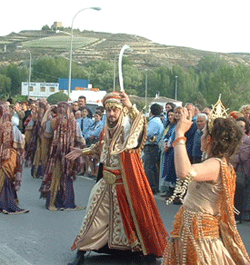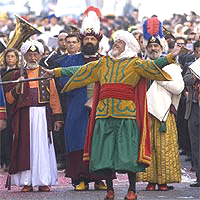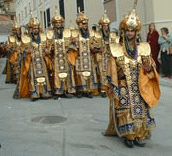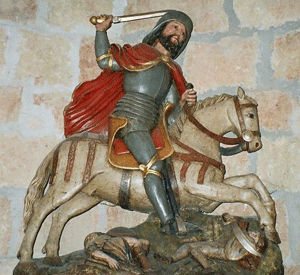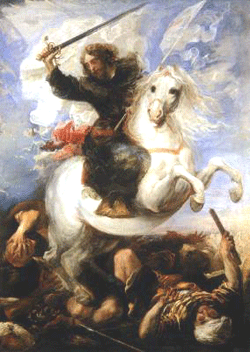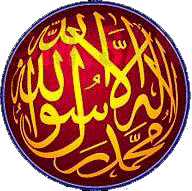
![]() The
Visigoths
retained a presence in Spain, with Toledo as their capital
until 715. In 718 the Saracens drove the Visigoths back
and took over the region North of the Pyrenees
(
The
Visigoths
retained a presence in Spain, with Toledo as their capital
until 715. In 718 the Saracens drove the Visigoths back
and took over the region North of the Pyrenees
( Pirenčus,
Pirenčus,
 Pirineus,
Pirineus,
 Pyrénées),
coming face to face with the Franks who had been conducting
a similar invasion but from the north of Europe. In the
West Moslem progress was checked at the Battle of Poitiers
in 732 by Charles Martel.
Pyrénées),
coming face to face with the Franks who had been conducting
a similar invasion but from the north of Europe. In the
West Moslem progress was checked at the Battle of Poitiers
in 732 by Charles Martel.
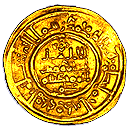
![]() In
the East the Saracens held on to Narbonne
and its dependent territories until Pepin the Short took
the fortress at Narbonne and expelled the Moors ("Saracens")
in 759.
In
the East the Saracens held on to Narbonne
and its dependent territories until Pepin the Short took
the fortress at Narbonne and expelled the Moors ("Saracens")
in 759.
From this period the Languedoc was an integral part not of Frankish states but of Iberian States - first Moslem, later Christian. The history of the Languedoc is therefore integrally connected to the history of the Iberian peninsular, and in particular of Aragon.
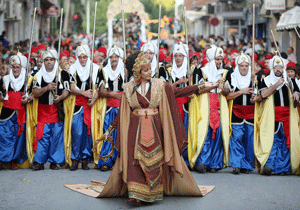
![]() The
culture of Islamic Spain was far ahead of that of the barbarian
Franks. It was by this route that ancient learning filtered
into Europe, feeding the Renaissance. There are many reminders
today of the Moslem presence, including architecture, water
systems, universities, festivals and food.
The
culture of Islamic Spain was far ahead of that of the barbarian
Franks. It was by this route that ancient learning filtered
into Europe, feeding the Renaissance. There are many reminders
today of the Moslem presence, including architecture, water
systems, universities, festivals and food.
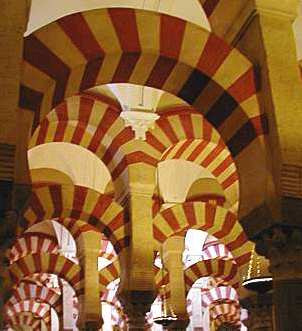
![]() In
the Languedoc you will find a few reminders of the presence
of the Moors, for example names such as Castelmaur (Castle
of the Moors) and Castelsarrasin (Castle of the Saracens),
the medical school at Montpellier, and odd remnants like
a doorway at Narbonne. Moslem coinage was used for centuries
alongside that struck by the Counts of Toulouse. Perhaps
the greatest legacy in Medieval times was religious tolerance,
and the tradition of poetry, music and song which can be
discerned in the development of the troubadours.
In
the Languedoc you will find a few reminders of the presence
of the Moors, for example names such as Castelmaur (Castle
of the Moors) and Castelsarrasin (Castle of the Saracens),
the medical school at Montpellier, and odd remnants like
a doorway at Narbonne. Moslem coinage was used for centuries
alongside that struck by the Counts of Toulouse. Perhaps
the greatest legacy in Medieval times was religious tolerance,
and the tradition of poetry, music and song which can be
discerned in the development of the troubadours.

![]() Below
is a summary of the Moslem period and of the so-called Reconquista
- seven-and-a-half century long process by which Catholic
Christians conquered the Iberian peninsula (modern Portugal
and Spain), eliminating the Muslim and Moorish states of
Al-Ándalus. It was not really a "Reconquest"
since Spain had never been Catholic - the Visigothic brand
of Christianity had been Arian.
Below
is a summary of the Moslem period and of the so-called Reconquista
- seven-and-a-half century long process by which Catholic
Christians conquered the Iberian peninsula (modern Portugal
and Spain), eliminating the Muslim and Moorish states of
Al-Ándalus. It was not really a "Reconquest"
since Spain had never been Catholic - the Visigothic brand
of Christianity had been Arian.
The Moorish Conquest of the Iberian Peninsular (710-756)
|
In the 5th century the Visigoths had been commissioned by the Western Roman Empire to reconquer Hispania from the Vandals and the Alans. In return, the Visigoths received Roman Hispania and Southern Gaul as foedus. In 476, the last Roman emperor was deposed by Odoacer, and the Visigoths had ruled Hispania as an independent kingdom. On the death of the Visigothic King Wittiza in 710, Roderic seized the kingdom and the Byzantine exarch. Roderic's enemies included Julian the Count of Ceuta; who was sheltering Wittiza's family and other partisans, along with Arians and Jews fleeing persecution at the hands of the Roman Catholic Church. Julian enjoyed good relations with the Moorish governor of nearby Tangier, Tariq ibn Ziyad and his emir Musa ibn Nusair. He provided ships for a Moorish force consisting of Africans, Berbers and Arabs to land in Gibraltar to assist him in his struggle with Roderic. Thus began the Umayyad conquest of Hispania from the Visigoths. Roderic, who had been fighting the Basques in the north, gathered his forces and marched south, where he was defeated by Tariqibn Ziyadatthe battle of Guadalete (at the Guadalete River in the south of the Iberian peninsula) in 711. .His defeat resulted in part from the desertion of Gothic troops under his command at the urging of Wittiza's brother Oppas, Bishop of Seville. After the battle, Visigothic rule fell apart, with Agila surrendering his lands in 712. Pelayo, a noble in charge of Roderic's royal guard (Comes Spatharius), escaped the battle and returned to his native Asturias to regroup. |
|
During the next three years, the Moors conquered the majority of Hispania, often helped and welcomed by indigenous peoples. After 714, most of the Iberian Peninsula was more commonly referred to by its Arabic name: Al-Andalus.
Spreading northwards, by 719 the Moors were attacking Septimania in southern Francia - the area now known as Languedoc. They conquered both Barcelona and Narbonne in 720. In 721 a mixed force of Aquitanians and Franks under Duke Odo of Aquitaine defeated a Muslim army commaded by the governor-general of Al-Andalus (al-Samh ibn Malik al-Khawlani) at the Battle of Toulouse. The Franks quickly surround and mortally wounded the Moorish commander and destroyed his forces (allegedly 375,000 Moslems) in what is still regarded as one of the worst military defeats in Muslim history. Muslim raids reached as far as Autun in Frankish territories in 725. The Moors were finally checked by Charles Martel in 732 at the Battle of Tours. The Moors then settled in the Iberian Peninsula, establishing an Emirate nominally subordinate to the Caliph in Damascus. Native lords were allowed to keep their property and social status as long as they embraced Islam, and the change of government did not seriously disrupt everyday affairs. County divisions were retained, but local administrators were replaced by Arab Muslims. Non-Muslims were obliged to submit to a series of discriminatory laws (the Code of Umar), ensuring the primacy of Islam over Christianity and Judaism in society.
In 729, Moslem Berbers in Cerdanya (a region in whatis now the French Pyrenees) changed allegiance. Supported by Duke Odo of Aquitaine they rebelled, but the rebellion was suppressed by Moslem forces. The two sides met again a few years later in 732, on the River Garonne near Bordeaux, when a Muslim army led by Abdul Rahman Al Ghafiqi defeated an Aquitanian force under Duke Odo of Aquitaine . The Moors then pillaged the Aquitaine.
A turning point came soon afterwards when the Frankish commander Charles Martel "Charles the Hammer" defeated a Muslim army some 60,000 strong at the Battle of Tours. Abdul Rahman Al Ghafiqi was killed and the northward advance of Islam in Europe was halted. Blocked to the north they took Avignon in the Rhône Valley in 737 and other cities including Narbonne.
Under the Umayyad Emirate of Córdoba (756-929) they lost Narbonne to the Franks in 759 their last conquest. In capturing this Narbonne, King Pippin the Younger ended Muslim rule north of Iberia.
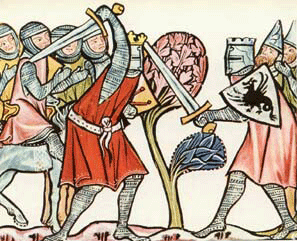
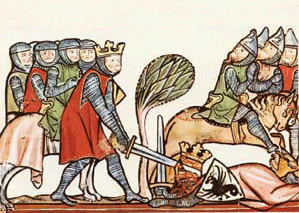
![]()
![]() The
Franks now started to attacked Moslem Spain. In 778 Franks
led by Charlemagne attacked Zaragoza, but wee forced to
withdraw. Basques ambushed Charlemagne's army as it crosses
the Pyrenees norwards out of Iberia. They maul the Frankish
rearguard badly, killing many of the commanders including
the Breton Markgraf Hruotland (the famous "Roland").
The
Franks now started to attacked Moslem Spain. In 778 Franks
led by Charlemagne attacked Zaragoza, but wee forced to
withdraw. Basques ambushed Charlemagne's army as it crosses
the Pyrenees norwards out of Iberia. They maul the Frankish
rearguard badly, killing many of the commanders including
the Breton Markgraf Hruotland (the famous "Roland").
In 792, Hisham I, Emir of Córdoba, called a Jihad against the infidels in Al-Andalus. Tens of thousands of Moslems from as far away as Syria heeded his call and crossed the Pyrenees to regain their lost territories. Cities including Narbonne were destroyed, but the invasion was halted at Carcassonne.
Soon the tables were turning again. In 800 Charlemagne took Barcelona and was granted the title of "Holy Roman Emperor" by Pope Leo III - a power building exercise by the papacy which had no right until then to appoint Emperors. This event caused outrage on the part of the real Emperor still based in Constantinople. After 800 the region around Barcelona would become a buffer state between the Frankish and Muslims lands - known as the Marca Hispanica (Hispanic Marches).
In 806 the Frankish conquered Pamplona, but failed to win Tortosa in 808. By now Charlemagne had gained control of all of Catalonia, completing his Hispanic Marches buffer state which was to hold until 874.
At this time it was common for various groups to form allegiances that were independent of religious affilliation. For example Gothic rebels attacked Barcelona in 827 with Umayyad support. Bernat of Septimania held the city against their allied forces. Lost later, it was regained in 848 by William, son of Bernat of Septimania.
In the quarter century from 873 Wilfred the Hairy, Count of Barcelona, established a Christian kingdom with a degree of independence from the Frankish kings.
By 920 Moslem power was waxing again. In that year Muslim forces crossed the Pyrenees, entered Gascony, and reached as far as the gates of Toulouse.
The Umayyad Caliphate (929-1031)
Moslems established in Provence became accepted as part of the political landscape from the coast to the Alps. In 940 Hugh, Count of Provence, give his protection to Moors in St. Tropez on condition that they agreed to keep Alpine passes closed to his rival Berenger. In 953 the Emperor Otto I sent representatives to Córdoba to ask Caliph Abd al-Rahman III to call off Muslim raiders who had set themselves up in Alpine passes and were attacking merchants going in and coming out of Italy.
The West the Navarese were active to. In 1000 Sancho III of Navarre, inflicted major losses on the Muslim forces. From then until 1033 he gained control of Aragon and Castile, uniting the two kingdoms with Navarre. On his death, he split the kingdom and leftNavarre to his son García III of Pamplona, Castile to Fernando I, and Aragon to Ramiro I.
The Almoravides Era (1031-1130)
By 1034 this time, Sancho III of Navarre ("Sancho the Great") had incorporated Aragon, Sobrarbe, Barcelona, as well as Asturias, León and Castile, and he proclaimed himself RexHispaniarum ("King of all Spains"). He died in 1035 and Bermudo III of León reclaimed the Leónese crown.Sancho's sons inherited his other territories; Garcia IV in Navarre including some territory of Old Castile; Ferdinand I in the new kingdom of Castile; Ramiro I in the new kingdom of Aragon.
|
At the Battle of Graus in spring 1063, Ramiro I of Aragon besieged Muslim Graus in Zaragozan territory. The Emir al-Muqtadir of Zaragoza lead his army north accompanied by a Castilian contingent under Prince Sancho (the future Sancho II). The opposing armies met; after a protracted struggle Ramiro I was killed (8 May 1063) and the Aragonese fled. Pope Alexander II sent an international force to Spain under his standard bearer William of Montreuil. This force included Italian knights, Normans (Robert Crespin, Baron of Lower Normandy), Aquitanians (William, Count of Poitiers and Duke of Aquitaine), and Iberians (Bishop of Vic; Count Ermengol II of Urgel). At the start of July the expedition besieged Barbastro in the Muslim Kingdom of Lerida. After 40 days the defenders surrendered.. Some 50,000 inhabitants were massacred or enslaved by the Christians. Count Ermengol II of Urgel was left as governor on behalf of Sancho Ramirez of Aragon. Just a couple of years later Civil War broke out in Castile-León. In April 1065 it was now the turn of Emir Al-Muqtadir of Zaragoza, aided by 500 Sevillian knights, to besiege Barbastro. The governor, Count Ermengol II of Urgel, was killed in a sortie, and a few days later the city fell. The Christian garrison was put to the sword, bringing an end to Pope Alexander II's prototype European crusade. Cross denominational allegances continued. In 1081 - Rodrigo Díaz de Vivar (El Cid) entered the service of the Moorish king of Zaragosa, al-Mu'tamin, and would remain there for his successor, al-Mu'tamin II. At the Battle of Almenar in 1082 El Cid, leading the army of Al-Mutamin of Zaragoza, defeated a combined army of the kings of Valencia (Al-Mundhir), Lerida (Al-Hayib), Aragón (Sancho Ramírez), and the Count of Barcelona (Berenguer Ramón II). At this time the Proto French Franks took to Crusading in the Iberian Peninsular. (The same families would provide later crusaders for the Holy Land and for the Albigensian Crusade - the War against the people of the Languedoc.) Raymond of Burgundy, son of William I, Count of Burgundy, came to Iberia for the 1st time in 1086 to fight against the Moors, bringing with him his younger cousin Henry of Burgundy, grandson of Robert I, Duke of Burgundy. In 1092 Toledo fell to the Reconquista to remain in Christian hands thereafter. Conquest meant new lands to own and rule. Raymond of Burgundy and Henry of Burgundy signed a treaty under which Henry promised to recognise Raymond as king upon the death of Alfonso VI of Castile, receiving in exchange the Kingdom of Toledo or of Portugal. In 1094 El Cid captured Valencia from the Moors, carving out his own kingdom along the Mediterranean that is nominally subservient to Alfonso VI of Castile. Valencia would be a model state, with both Christian and Muslims living there and serving in his army. By the early twelfth century Moorish forces were advancing north once again. By 1112 they were raiding into Aragonese territory and would soon reach the foothills of the Pyrenees. In 1115 the new Murabitun governor of Zaragoza, Abu Bakr ibn Ibrahim ibn Tifilwit, lay siege to Barcelona for 20 days. He withdraw when Count Ramon Berengar III returned from Majorca. His fleet taking off to sieze the Balearic Islands. |
|
Now the tide turned again. Alfonso I of Aragon took Saragossa from the Muslims in 1118 - to remain in Christian hands thereafter. In 1120 Alfonso decisively defeated a Murabitun army at Cutanda, and the following year the Aragonese took Calatayud.
Decline and submission to Christian rule (1130-1481)
|
Counter offensives continued. In 1130 Tashfin ibn Ali ibn Yusuf (the son of the Murabitun Emir) retook the castle of Aceca south of Toledo. The Murabitun (Governor of Valencia) defeated invading Aragonese and killed Gaston IV of Béarn (who had been involved in the First Crusade). In 1137 the Kingdom of Aragon and County of Catalonia were united. In the High Middle Ages, the fight against the Moors in the Iberian Peninsula became linked to the fight of the whole of Christendom. The Reconquista was originally a mere war of conquest. It only later underwent a significant shift in meaning toward a religiously justified war of liberation (the Augustinian concept of a Just War). The papacy and the influential Abbey of Cluny in Burgundy not only justified the anti-Islamic acts of war but actively encouraged Christian knights to seek armed confrontation with Moorish "infidels" instead of with each other. From the 11th Century onwards indulgences were granted: In 1064 Pope Alexander II promised the participants of an expedition against Barbastro a collective indulgence 30 years before Pope Urban II called the First Crusade. Not until 1095 and the Council of Clermont did the Reconquista amalgamate the conflicting concepts of a peaceful pilgrimage and armed knight-errantry. The papacy left no doubt about the heavenly reward for knights fighting for Christ (militia Christi): in a letter, Urban II tried to persuade the reconquistadores fighting at Tarragona to stay in the Peninsula and not to join the armed pilgrimage to liberate Jerusalem since their contribution for Christianity was equally important. The pope promised them the same rewarding indulgence that awaited the first crusaders. |
|
An international Christian coalition attacks Almería by land and sea in 1147. Alfonso VII of Castile and Sancho Ramirez IV of Navarre marched overland taking Andujar and Baeza en route. Ramon Berengar IV of Aragon-Catalonia and a Genoese naval contingent joined them at Almería. Almería fell on 17 Oct and was given to the Genoese (who already have a powerful presence in the Western Mediterranean Sea).
In the same yeara fleet of almost 200 ships of the Second Crusade left Dartmouth in England. The fleet arrived at the Portuguese city of Porto, and were convinced by the bishop, Pedro II Pitões, to attack Lisbon, then held by the Moors. The Crusaders joined forces with the armies of King Afonso I of Portugal and the Siege of Lisbon began on 1st July. On 21st October the Moorish rulers of Lisbon agreed to surrender to King Afonso I of Portugal. Under the terms of surrender the Muslim garrison of the city would be allowed to flee. The city opened its doors to the Christian armies on 25th October. All Muslims were killed, and the city was plundered before King Afonso I was able to stop the slaughter. Lisbon would remain in Christian hands thereafter.
Another major victory for the Christians followed in 1212 at the Battle of Las Navas de Tolosa. Alfonso VIII of Castile, Sancho VII of Navarre, Pedro II of Aragon and Afonso II of Portugal, working together defeated the Almohad Caliph Muhammad an-Nasir. The Christians had 60-100,000 infantry and 10,000 cavalry. After the defeat the Almohad empire would go into decline not only in Spain but also in North Africa.
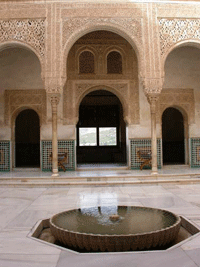
![]() Attidudes
to Jews varied. Local Christians in Spain as in the Languedoc
were tolerant, but the Roman Catholic authorities were not.
During the reign of King Jaime I of Aragon (1213-1276) Jews
from France and North Africa were encouraged to settle in
Aragon with land and property grants and exemptions from
taxes. But Pope Innocent III's Fourth Lateran Council of
1215 instituted the "Badge of Shame": all Jews
were required to wear yellow bedges to distinguish themselves
from Christians, and it was decreed that Jews must not be
seen in public on Good Friday. Fernando III, appealled to
the Pope on behalf of Iberian Jews. Innocent's successor
pope, Honorius II, suspended the decision for the time being.
Attidudes
to Jews varied. Local Christians in Spain as in the Languedoc
were tolerant, but the Roman Catholic authorities were not.
During the reign of King Jaime I of Aragon (1213-1276) Jews
from France and North Africa were encouraged to settle in
Aragon with land and property grants and exemptions from
taxes. But Pope Innocent III's Fourth Lateran Council of
1215 instituted the "Badge of Shame": all Jews
were required to wear yellow bedges to distinguish themselves
from Christians, and it was decreed that Jews must not be
seen in public on Good Friday. Fernando III, appealled to
the Pope on behalf of Iberian Jews. Innocent's successor
pope, Honorius II, suspended the decision for the time being.
Between 1217 and 1252 Fernando III, king of Castile and León, conquered Córdoba, Murcia, Jaen, and Seville, leaving Granada as the sole independent Muslim kingdom. Denia fell in 1227, Badajoz in 1228.
Jaime I of Aragon, Jaime the Conqueror, retook Majorca, Jerica and Murviedro-Sagunto in 1229 all of which would remain in Christian hands thereafter. Sonn after he retook Valencia, Albarracin, Alpuente, and Tortosa all of which would remain in Christian hands thereafter. In 1243 Jaime took Murcia from the Moors.
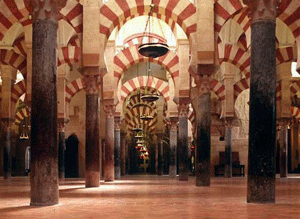
![]() Ibiza
and Jaen fell to the Reconquista in 1232, and in the same
year forces under Ferdinand III of Castile recaptured Córdoba.
The ruler of Granada, Mohammed ibn Alhamar, approached Ferdinand
III of Castile to propose that in return for cooperating
in the conquest of Muslim Seville, Granada would be granted
independence as a subject of Castile. Fernando agreed, and
so it was. Granada became a vassal state of the Christian
kingdom for a further 250 years.
Ibiza
and Jaen fell to the Reconquista in 1232, and in the same
year forces under Ferdinand III of Castile recaptured Córdoba.
The ruler of Granada, Mohammed ibn Alhamar, approached Ferdinand
III of Castile to propose that in return for cooperating
in the conquest of Muslim Seville, Granada would be granted
independence as a subject of Castile. Fernando agreed, and
so it was. Granada became a vassal state of the Christian
kingdom for a further 250 years.
Arjona and Baeza fell to the Reconquista in 1244, followed by Carmona in 1246, Arcos, Constantina, Huelva, Jerez, Moron, Ronda, Saltes and Segorbe (1248); Orihuela (1249); Mertola, Santa Maria del Algarbe , Silves , Tavira , Tejada , Constantina , Huelva , and Jerez (1250); Niebla (1262); Lorca ,Murcia ,Purchena and Segura (1266), all of which would remain in Christian hands.
In 1272 King Afonso III of Portugal took Faro in the Algarve from the Moors, removing the last Muslim state from Portuguese soil and completing the Portuguese Reconquista.
As the Reconquista continued, War between the Christian states of France and Aragon-Catalonia broke out in 1285, but this did not afect Christian advances elsewhere. Menorca and Algeciras both fell to the Reconquista 1287
In 1345 the Kingdoms of Catalonia-Aragon and Rousillon-Majorca were united.
In this period The Black Death struck Europe, ariving frm the East in 1348.
Castile-Aragón conquered the kingdom of Granada between 1481 and 1491, Málaga falling in 1487 and Guadixin 1491.
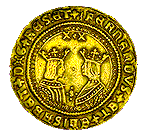
![]() On
January 2, 1492, the last Muslim ruler, Abu 'abd Allah Muhammad
XII (also known as Boabdil of Granada), surrendered to Los
Reyes Católicos ("The Catholic Monarchs"),
Queen Isabella of Castile and King Ferdinand II of Aragon.
Ferdinand and Isabella now ruled Granada. The modern Country
of Spain, unifying Aragon, Castile and Granada, dates from
this time, though it was not completed until 1512 when the
Kingdom of Navarre south of the Pyrenees was annexed by
Ferdinand II of Aragon. From this time the Iberian peninsula
has been made up of two Christian states, Spain and Portugal.
On
January 2, 1492, the last Muslim ruler, Abu 'abd Allah Muhammad
XII (also known as Boabdil of Granada), surrendered to Los
Reyes Católicos ("The Catholic Monarchs"),
Queen Isabella of Castile and King Ferdinand II of Aragon.
Ferdinand and Isabella now ruled Granada. The modern Country
of Spain, unifying Aragon, Castile and Granada, dates from
this time, though it was not completed until 1512 when the
Kingdom of Navarre south of the Pyrenees was annexed by
Ferdinand II of Aragon. From this time the Iberian peninsula
has been made up of two Christian states, Spain and Portugal.

![]() 1492
was a pivotal date. Secure in its borders Spain funded sea
expeditions such as that of Christopher Columbus the same
year. Following the Christian victory, Moslems and Jews
were given a chooice of exile, conversion or death. So many
left that within a few years the economy would collapse.
1492
was a pivotal date. Secure in its borders Spain funded sea
expeditions such as that of Christopher Columbus the same
year. Following the Christian victory, Moslems and Jews
were given a chooice of exile, conversion or death. So many
left that within a few years the economy would collapse.
Most Muslims and Jews were forced to either convert to Christianity or leave Spain and Portugal and have their assets seized. Many Muslims and Jews moved to North Africa rather than submit to forced conversion. The Christian hierarchy demanded heavy taxes and gave them nominal rights, but only in heavily Islamic regions, such as Granada, until their own power was sufficient, and the influence of the Inquisition strong enough, to make further expulsion both possible and economically feasible. In 1496, under Archbishop Hernando de Talavera, the Muslim population of Granada was forced to accept Christianity. In 1502, the Catholic Kings declared submission to Catholicism officially compulsory in Castilian domains. Emperor Charles V did the same for the Kingdom of Aragon in 1526.
Descendants of those Muslims and Jews who submitted to compulsory conversion to Christianity rather than exile during the early periods of the Inquisition, the Moriscos and Conversos respectively, were later expelled from Spain and Portugal when the Inquisition was at its height. The expulsion was carried out more severely in Eastern Spain (Valencia and Aragon), due to local animosity towards Muslims and Moriscos - mainly for economic reasons.
Because some Muslims, and Jews, shared common ancestors with Christians, it was difficult to expel all of those with non-Christian ancestors from Iberia. However the Spanish state had some success in expelling the "Moriscos". Those descended from practicing Muslims or Jews at the time of the Reconquista, however, were for a long time suspected of various crimes including practicing Islam or Judaism, or crimes against the Spanish state and finally expelled from peninsula.
The last rules of ethnic and religious purity of the Modern Age were the Spanish limpieza de sangre and the expulsion of Jews by Manuel I in Portugal.

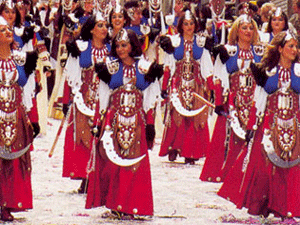
![]()
![]() Reminders
of the Reconquista are the festivals of moros y cristianos
(Castilian or Spanish), mors i cristians (Valencian or Catalan)
and mouros e cristãos (Portuguese or Galician) these
meaning "Moors and Christians" recreate the fights
as colorful parades with elaborate clothes and fireworks,
especially on the Spanish Mediterranean
coast, popularly known as Levante.
Reminders
of the Reconquista are the festivals of moros y cristianos
(Castilian or Spanish), mors i cristians (Valencian or Catalan)
and mouros e cristãos (Portuguese or Galician) these
meaning "Moors and Christians" recreate the fights
as colorful parades with elaborate clothes and fireworks,
especially on the Spanish Mediterranean
coast, popularly known as Levante.
